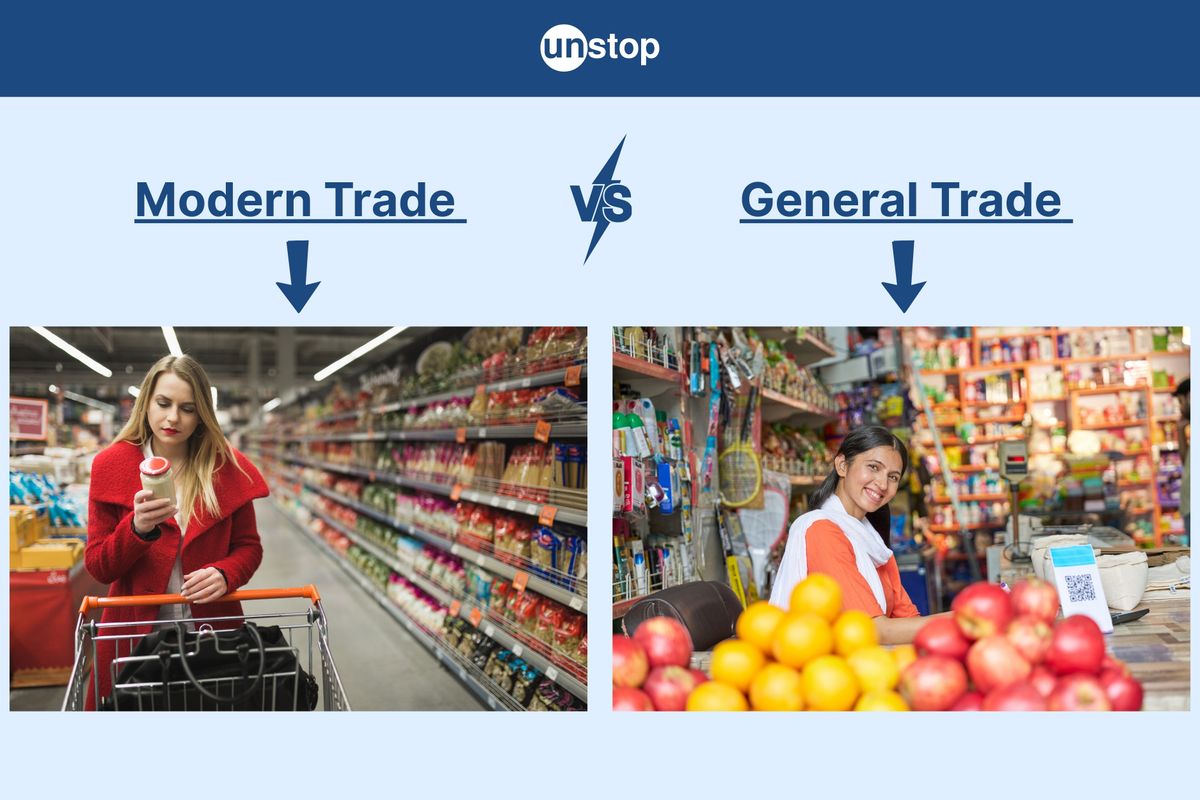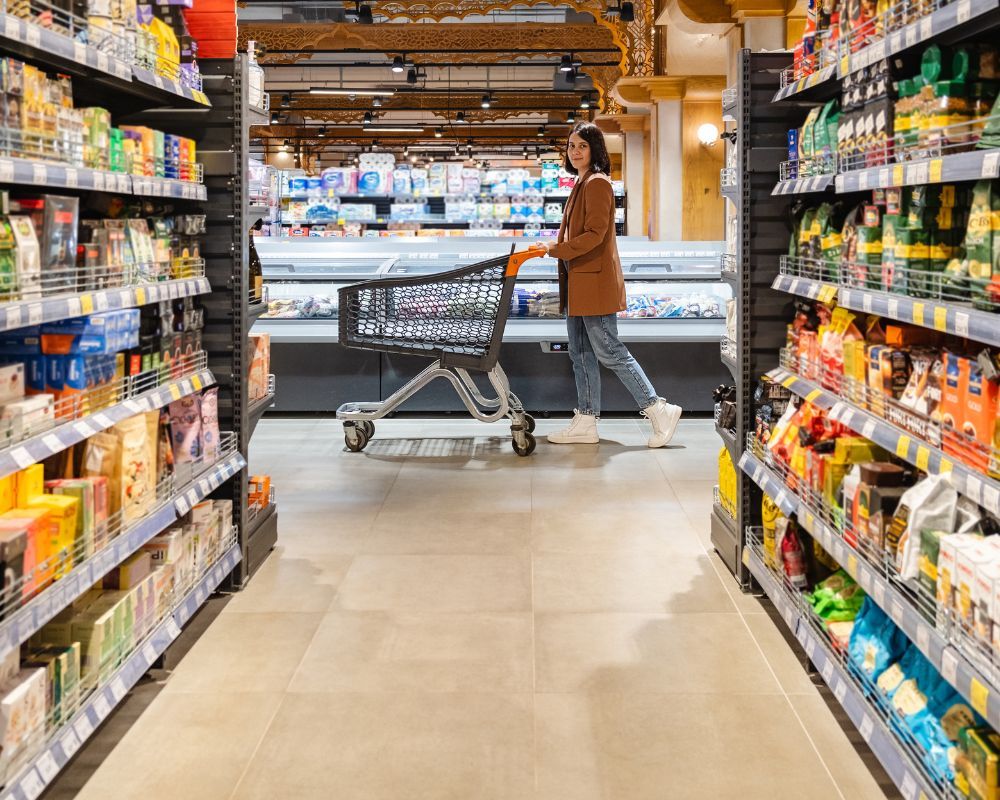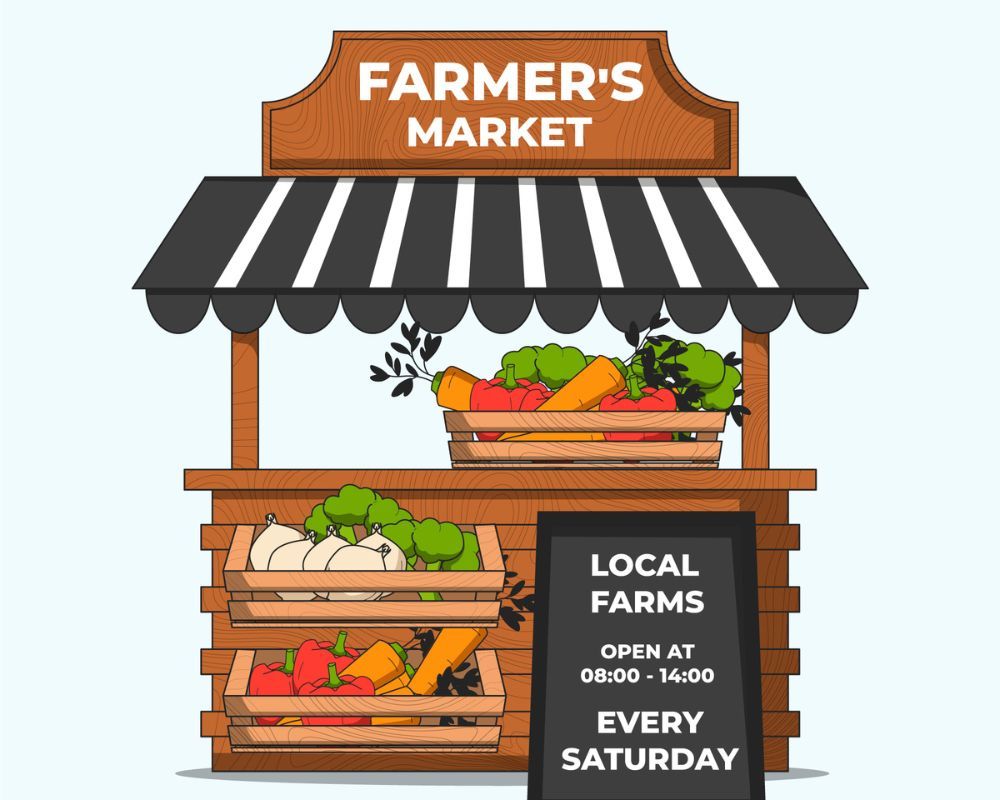- What is Modern Trade?
- Strategic Business Planning In Modern Trade
- What is General Trade?
- Strategic Business Planning in General Trade
- Key Differences Between Modern Trade and General Trade
- How Modern and General Trade Work in FMCG Sectors?
- Challenges in Modern Trade vs General Trade and Solutions
- Future Trends In Trading Practices
- Frequently Asked Questions (FAQ)
Modern Trade Vs General Trade: Understanding The Key Differences

In the world of retail, two major types of distribution channels dominate the landscape General Trade and Modern Trade. Understanding the difference between them helps businesses, marketers, and even consumers make better choices. This article explores the key distinctions between modern and general trade, providing valuable insights into the advantages and competition that come with this approach.
What is Modern Trade?
Modern Trade (MT) refers to organized retail outlets that follow a structured and technology-driven approach to selling. This includes supermarkets, hypermarkets, Department stores, online retailers (e-commerce), and convenience chains like Reliance Fresh, Big Bazaar, D-Mart, etc. Large retail chains or corporations typically own these modern trade outlets.
An example of modern trade is a D-Mart outlet offering discounts on bulk grocery purchases or an online BigBasket order.

Key Characteristics Modern Trade
Key characteristics of modern trade include the following:
- Organized and systematized operations.
- Uses barcode scanners, billing software, and inventory management systems.
- Offers discounts, loyalty programs, and bulk-buy options.
- Larger floor space, attractive displays, and a wider variety of products.
- Focus on customer experience and brand positioning.
Strategic Business Planning In Modern Trade
In the realm of modern trade, companies must develop strategic plans. It must align with the trends and demands of the consumer to be able to stay competitive and maximize their growth potential.
Market Research & Analysis
One key aspect of strategic business planning in modern trade is conducting thorough market research and analysis. By understanding the dynamics of the market and identifying emerging opportunities, businesses can position themselves strategically to capitalize on these trends.
This involves studying consumer behavior, analyzing competitors' strategies, and evaluating market demand for specific products or services.
Collaboration With Key Stakeholders
Collaboration with key stakeholders also plays a vital role in enhancing business planning in modern trade. Engaging with logistics management companies can help streamline supply chain management, ensuring efficient inventory management and timely delivery of goods.
Collaborating with distributors and retailers enables businesses to gain insights into consumer preferences, optimize sales strategies, and effectively reach their target market.
Leveraging Technology
Effective business planning in modern trade also involves leveraging technology to enhance operational efficiency. Companies can utilize advanced analytics tools to gain better insights from huge volumes of data generated by sales transactions, customer interactions, and market trends.
This data-driven approach helps identify patterns, predict future demand, and make informed decisions regarding product assortment, pricing strategies, and promotional activities.
Personalized Experiences For Customers
To further strengthen their strategic business planning efforts in modern trade, companies should focus on building strong relationships with customers through personalized experiences. By understanding customer needs and preferences at a granular level, businesses can tailor their offerings accordingly and create a loyal customer base.
What is General Trade?
General Trade (GT) refers to the traditional retail system where small, often family-owned shops sell products directly to customers. Examples of general trade include Local grocery shops, General provision stores, and Small wholesalers. These are typically independently owned and operated businesses. General trade outlets are often located in residential areas or local markets, making them easily accessible to consumers.
A typical example of a general trade in the context of India is a small Kirana store in your neighborhood that stocks daily groceries, snacks, soaps, and detergents. This is a classic example of General Trade.

Key Characteristics of General Trade
Some of the important characteristics of general trade are:
- Usually unorganized and informally run.
- Credit-based transactions are common.
- Limited product display and store size.
- One-on-one personal relationships with customers.
- Inventory is often purchased from distributors or wholesalers.
Strategic Business Planning in General Trade
General trade involves small, neighborhood stores that rely on personal relationships and localized strategies to stay competitive. Here’s how strategic planning is done in this space:
1. Understanding Local Needs
Shopkeepers closely observe customer preferences and seasonal trends to stock items that are most in demand. This localized knowledge helps them serve customers effectively without needing advanced analytics.
2. Simple Inventory Management
Due to limited space, general trade retailers focus on fast-moving items and avoid overstocking. They use basic methods like notebooks or simple digital tools to track inventory and reorder efficiently.
3. Strong Supplier Relationships
Personal rapport with distributors and wholesalers helps shopkeepers access better pricing, flexible credit, and new products, giving them an edge in pricing and availability.
4. Local Promotions & Word-of-Mouth
Instead of large-scale ads, shopkeepers use personal service, small discounts, and festive offers to retain customers. Their reputation in the community is a key marketing asset.
5. Adoption of Basic Technology
While not tech-heavy, many stores are adopting tools like UPI, mobile apps, and local e-commerce platforms. This enhances convenience and supports smoother daily operations.
Key Differences Between Modern Trade and General Trade
Let us now study the key differences between modern trade vs general trade:
|
Aspect |
Modern Trade |
General Trade |
|
Infrastructure |
Operates on a large scale with spacious, air-conditioned stores, organized aisles, attractive displays, and modern facilities. |
Small local shops or kiosks with limited space and basic infrastructure. |
|
Product Range |
Offers a wide variety of products across multiple categories and brands, including niche and premium items. |
Stocks mostly fast-moving consumer goods and essentials due to limited space. |
|
Pricing Strategy |
Uses economies of scale to offer competitive pricing, discounts, and bundle deals. |
May offer flexible pricing based on supplier relationships and local competition. |
|
Customer Experience |
Emphasizes self-service, modern billing counters, loyalty programs, and in-store amenities like cafes. |
Focuses on personal interaction, trust, and long-standing customer relationships. |
|
Technology Use |
Uses digital billing systems, inventory software, barcoding, mobile apps, and digital payments. |
May rely on manual billing, cash payments, and traditional inventory tracking. |
|
Market Reach |
Prominent in urban and semi-urban areas, especially in malls and commercial centers. |
Widespread in rural and local neighborhoods, easily accessible to local consumers. |
|
Inventory Management |
Automated, centralized stock management and restocking processes. |
Manual stock tracking, often based on experience and frequent supplier visits. |
|
Brand Promotions |
Hosts in-store promotions, sampling campaigns, end-cap displays, and cross-promotions. |
Limited promotions, mostly word-of-mouth or local brand familiarity. |
|
Workforce |
Staffed with trained employees for customer service, billing, and merchandising. |
Often family-run with a few helpers or one-on-one service by the shop owner. |
How Modern and General Trade Work in FMCG Sectors?
The Fast-Moving Consumer Goods (FMCG) sector depends heavily on two main distribution channels: Modern Trade and General Trade. Both channels play a crucial role in ensuring products reach consumers efficiently, but they operate quite differently in terms of scale, technology, and customer experience.
Role Of Modern Trade In FMCG
Modern trade and general trade are two different distribution channels in the Fast-Moving Consumer Goods (FMCG) sector. Both play a vital role in the distribution and availability of FMCG products to consumers.
Modern trade offers a wide range of FMCG products under one roof and provides a convenient shopping experience for consumers. Modern trade outlets often have a well-designed layout, attractive displays, and efficient supply chain management systems.
One of the key advantages of modern trade is the ability to offer a variety of FMCG products to consumers. These outlets have larger shelf spaces compared to traditional stores, allowing them to stock a greater assortment of products. This gives consumers more choices and enables them to find everything they need in one place.
In addition, modern trade outlets often have better infrastructure and facilities compared to general stores. They invest in technologies like barcode scanners, electronic billing systems, and inventory management software, which help streamline operations and improve efficiency.
How Modern Trade Works in FMCG Sectors?
Bulk Purchase by Retail Chains: Large retailers buy FMCG products in bulk directly from manufacturers or distributors at negotiated prices.
Warehouse & Logistics Systems: Products are transported to centralized warehouses and then distributed to retail stores using efficient supply chains.
Use of Technology: Barcode systems, POS (Point of Sale) machines, and data analytics are used for stock management and consumer behavior analysis.
Promotional Support: FMCG brands collaborate with modern retailers to offer in-store promotions, discounts, and product displays to attract consumers.
Customer Experience: Shoppers enjoy air-conditioned stores, self-service, digital payments, and a wide product variety under one roof.
Role Of General Trade In FMCG
General trade outlets play a significant role in serving the needs of local communities. They offer convenience to consumers who prefer to shop for their daily needs closer to their homes. These stores often have loyal customer bases built over years of personalized service and relationships with their customers.
While general trade outlets may not offer the same variety of products as modern trade outlets, they often specialize in specific categories or cater to niche markets. This allows them to meet the unique preferences and demands of their local customers. General trade outlets also provide employment opportunities at the local level.
How General Trade Works in FMCG Sectors?
Distributor Network: FMCG companies appoint local distributors who supply products to retailers on a regular basis.
Direct Retailer Interaction: Shopkeepers maintain strong personal relationships with customers and recommend products based on trust and familiarity.
Credit-Based Sales: Many general trade retailers operate on credit, both from distributors and to customers.
Low Operating Costs: With minimal infrastructure and labor, these stores operate cost-effectively in small spaces.
High Reach: They have deep penetration, even in remote areas where modern trade has limited or no presence.
Challenges in Modern Trade vs General Trade and Solutions
| Aspect | Modern Trade (Challenges) | Solutions (Modern Trade) | General Trade (Challenges) | Solutions (General Trade) |
|---|---|---|---|---|
| Inventory Management | Overstocking or stockouts due to bulk operations | Implement real-time inventory systems using data analytics | Manual tracking can lead to poor inventory visibility | Provide digital inventory tools or mobile apps |
| High Operating Costs | Rent, staff salaries, maintenance, and technology upkeep | Optimize store layout, use automation, and reduce energy consumption | Limited margins make it hard to upgrade infrastructure | Offer retailer schemes and shared logistics support |
| Consumer Loyalty | Easy brand-switching due to offers from competitors | Launch loyalty programs, personalized discounts | Loyalty depends heavily on personal relationships | Train shopkeepers on CRM and engagement techniques |
| Technological Dependence | Downtime or glitches can disrupt operations | Maintain backup systems and regular IT maintenance | Lack of tech adoption limits efficiency | Introduce simple POS systems and digital billing options |
| Complex Supply Chain | Multiple stakeholders and centralized logistics complexity | Use integrated supply chain management platforms | Delayed deliveries from distributors | Strengthen last-mile delivery through micro-logistics partnerships |
| Space Constraints | Need large retail space in prime locations | Explore smaller format stores or “express” models | Very limited space for stocking and display | Encourage smart shelf management and priority stocking |
| Changing Consumer Behavior | Shift to online shopping, demand for convenience | Blend offline with online via an omnichannel strategy | Younger customers moving to modern trade and online | Enable WhatsApp orders, home delivery, or digital catalogs |
| Compliance & Regulations | Must comply with strict laws (GST, FSSAI, etc.) | Employ trained compliance officers and use automated filing tools | May lack formal registration or licenses | Run awareness campaigns and offer help in documentation |
Future Trends In Trading Practices
Let us look at the future of trading and its overall prospects in a fast-advancing technology and competition:
Technology Will Shape The Future Of Trading Practices
As we look ahead to the future, it is clear that technology will continue to play a significant role in shaping trading practices. Using artificial intelligence and data analytics, businesses can now gather valuable insights into consumer behavior and market trends.
The integration of technology also brings about improved efficiency and convenience in modern trade. Online platforms and e-commerce websites have made it amply easier for consumers to access a variety of products like never before from the comfort of their own homes.
Personalization & Customization
In the future, personalization and customization will become increasingly important in modern trade. Consumers are seeking unique experiences tailored specifically to their preferences. Businesses that can offer personalized recommendations based on individual needs and preferences will have a competitive edge.
With advancements in technology, businesses can collect vast amounts of data on consumer behavior, purchase history, and preferences. By analyzing this data, companies can create personalized offers, promotions, and product recommendations that resonate with each customer.
Sustainability & Ethical Considerations
Another significant trend that will influence trading practices is sustainability and ethical considerations. With increased consumer awareness about the environmental impact of their choices, they are demanding products that are sourced responsibly and manufactured sustainably.
Businesses need to adapt by incorporating sustainable practices into their supply chains. This includes using eco-friendly materials, reducing waste through recycling initiatives, and promoting fair labor practices throughout their operations.
Conclusion
In conclusion, we see that both general and modern trade are vital to FMCG's growth. While general trade dominates rural India due to reach and relationships, modern trade is rapidly growing in urban centers due to convenience, technology, and changing consumer lifestyles. A balanced strategy ensures brands reach diverse customer segments efficiently.
Frequently Asked Questions (FAQ)
1. What is modern trade?
Modern trade refers to a contemporary form of trading that involves large-scale retail outlets, such as supermarkets, hypermarkets, and department stores. It typically follows a structured approach with organized supply chains, advanced technology integration, and standardized business practices.
2. How does modern trade differ from traditional trade?
Modern trade differs from traditional trade in terms of scale, organization, and practices. While traditional trade involves small-scale retailers or individual sellers operating independently, modern trade encompasses large retail chains with centralized management systems and standardized processes.
3. What are the key distinctions between general trade and modern trade?
General trade refers to the broader concept of all types of trading activities encompassing both traditional and modern forms. On the other hand, modern trade specifically focuses on large-format retailing characterized by organized supply chains, advanced technology adoption, and standardized business practices.
4. How has modern trade evolved over time?
Modern trade has evolved significantly over time due to advancements in technology, changing consumer preferences, and market dynamics. It has transitioned from small independent stores to larger retail chains with sophisticated inventory management systems, online platforms for sales, and enhanced customer experiences.
5. What impact does modern trade have on brands and businesses?
Modern trade offers brands and businesses greater exposure through wider distribution networks than traditional channels. It provides opportunities for increased brand visibility, economies of scale in production or sourcing, improved access to target markets, and potential collaborations with retailers for mutual growth.
Suggested reads:
Alekhya Chakrabarty is a father, a doodler, a trivia buff, a sports fanatic and a lifelong student of marketing. Alekhya is the VP of Marketing & Growth at Unstop, the engagement and hiring platform which connects students and graduates with opportunities. He has over a decade and a half of experience in driving revenue and building brands with the likes of Nestle, HUL and ITC. He is an alumnus of IMT Ghaziabad and in his last stint he was leading the marketing function at Sunstone, a higher education startup. Alekhya has been recognised as a ‘Top Voice’ on LinkedIn for Digital Marketing & Brand Management. He runs a marketing podcast titled East India Marketing Company to drive conversations around growth, content, culture and commerce.
Login to continue reading
And access exclusive content, personalized recommendations, and career-boosting opportunities.
Subscribe
to our newsletter
















Comments
Add comment